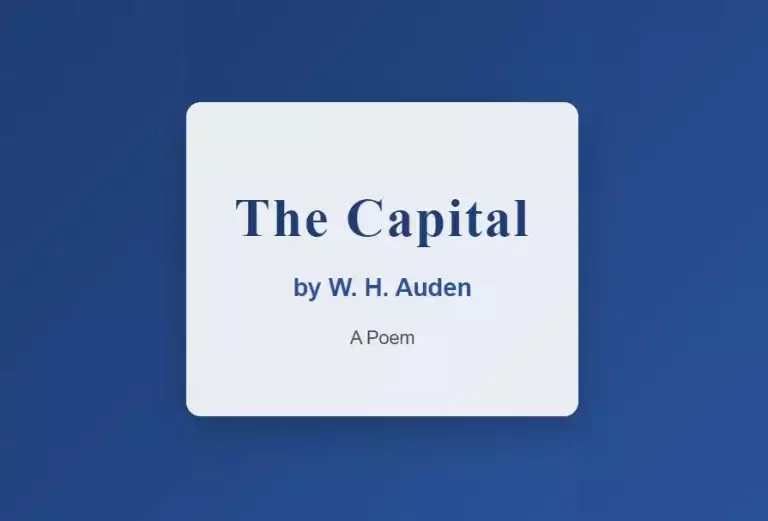W. H. Auden, one of the most influential poets of the 20th century, crafted “The Capital” as a powerful commentary on modern urban life and societal values. This poem, part of Auden’s later works, showcases his mastery of form and his keen observations of the human condition. “The Capital” explores themes of alienation, materialism, and the loss of individuality in the face of an increasingly mechanized world.
Table of Contents
Through its vivid imagery and incisive critique, the poem offers a stark reflection on the nature of modern existence, challenging readers to confront the realities of life in a capitalist society. Auden’s work stands as a significant contribution to modernist poetry, offering a profound and lasting insight into the complexities of contemporary urban life.
Brief Summary
“The Capital” presents a series of interconnected vignettes depicting life in a modern city. Auden paints a picture of a bustling metropolis, filled with anonymous figures going about their daily routines. The poem’s structure mirrors the fragmented nature of urban existence, jumping from scene to scene, offering glimpses into various aspects of city life.
Through these snapshots, Auden explores the tension between individual identity and collective society, the pervasive influence of commerce and industry, and the sense of isolation that persists even in the midst of crowds. The capital city serves as a microcosm for broader societal issues, allowing Auden to comment on the human condition in the modern age.
The Metropolis as Metaphor
Auden uses the city as a powerful metaphor for modern society at large. The urban landscape becomes a character in itself, embodying the contradictions and complexities of contemporary life. In lines such as “The monotonous hum of traffic” and “Skyscrapers loom like indifferent giants,” Auden creates a sense of an overwhelming and impersonal environment.
This portrayal of the city reflects the poet’s concerns about the dehumanizing effects of urbanization and industrialization. The capital becomes a symbol of progress and alienation simultaneously, challenging readers to consider the true cost of societal advancement.
The Individual vs. The Collective
A central theme in “The Capital” is the struggle between individual identity and collective society. Auden presents a series of anonymous figures, “Faceless crowds surge through neon-lit streets,” highlighting the loss of individuality in the urban masses. This tension is further explored through contrasting images of personal moments and public spaces.

The poem suggests that while the city offers opportunities for connection, it also fosters a profound sense of isolation. Auden’s portrayal raises questions about the nature of community and belonging in the modern world, inviting readers to reflect on their own experiences of urban life.
Materialism and Consumerism
Auden’s critique of capitalist society is particularly evident in his treatment of materialism and consumerism. The poem is peppered with images of commerce and industry, from “Shop windows gleam with desires unfulfilled” to “The stock exchange buzzes with frenzied activity.”
These vivid descriptions highlight the pervasive influence of economic forces on urban life. Auden suggests that the pursuit of material wealth has become a driving force in society, often at the expense of more meaningful human connections. The poem challenges readers to consider the true value of the goods and services that dominate city life.
Time and Routine in the Urban Landscape
The concept of time and its relationship to urban routines is another significant aspect of “The Capital.” Auden creates a sense of relentless forward motion, with lines like “Clock towers chime the hours away” and “Commuters rush to catch the last train home.”
This emphasis on time reflects the regimented nature of city life, where schedules and deadlines dictate the rhythms of existence. The poem suggests that this rigid adherence to time contributes to the sense of alienation and mechanization that characterizes modern urban society. Auden invites readers to question whether this structure enhances or diminishes the quality of human life.
Literary Techniques in “The Capital”
Auden employs a variety of literary techniques to convey his message in “The Capital.” The poem’s structure, with its rapid shifts between scenes and images, mirrors the fragmented nature of urban experience. This technique, known as montage, creates a sense of disorientation that reflects the overwhelming nature of city life.
Auden also makes extensive use of personification, giving human qualities to inanimate objects of the city, such as “Buildings huddle together for warmth.” This device emphasizes the idea of the city as a living entity. Additionally, Auden’s use of vivid sensory imagery, particularly visual and auditory elements, brings the urban landscape to life, immersing the reader in the sights and sounds of the capital.
Critical Reception and Impact
“The Capital” has been widely recognized as a significant work in Auden’s oeuvre and in modernist poetry more broadly. Critics have praised its incisive critique of modern society and its masterful use of poetic techniques to capture the essence of urban life. The poem’s themes continue to resonate with contemporary readers, as issues of urbanization, alienation, and the impact of capitalism remain relevant in today’s world.
Auden’s work has influenced subsequent generations of poets and thinkers, contributing to ongoing discussions about the nature of life in modern cities. Over time, “The Capital” has come to be seen not just as a critique of a specific historical moment, but as a timeless reflection on the human condition in an increasingly urbanized world.
Conclusion
“The Capital” stands as a powerful testament to W. H. Auden’s poetic genius and his ability to capture the complexities of modern life. Through its vivid imagery, incisive social commentary, and masterful use of literary techniques, the poem offers a profound exploration of urban existence in the 20th century. Auden’s work challenges readers to confront the realities of life in a capitalist society, questioning the values and structures that shape our daily experiences.
As cities continue to grow and evolve, “The Capital” remains a relevant and thought-provoking piece, inviting us to reflect on our place within the urban landscape and the broader human community. Ultimately, Auden’s poem serves as both a critique and a call to awareness, urging us to consider how we might create more meaningful connections and experiences within the complex tapestry of modern urban life.



1 Comment
Pingback: Lullaby by W. H. Auden: A Deep Dive into Love, Mortality, and Human Connection - LitGram by MukeshRishit